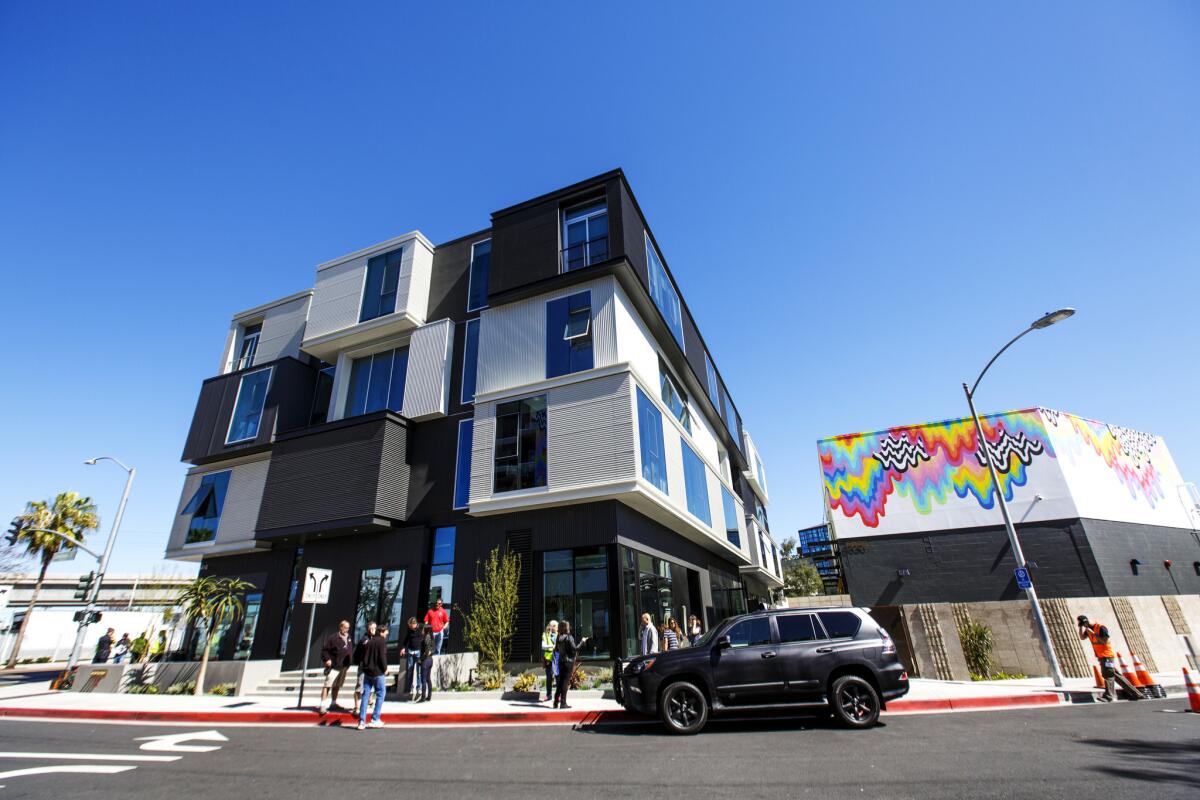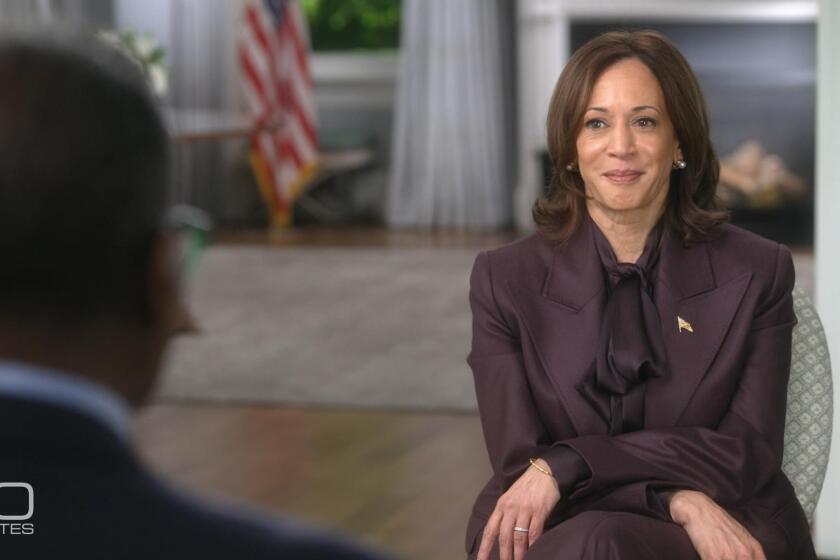Amid housing crisis, Culver City is the latest town to cap rents

- Share via
Culver City approved a temporary rent control measure early Tuesday morning, joining a handful of other Southern California cities that have boosted tenant protections as the state grapples with an affordability crisis.
In a 4-1 vote that followed a five-hour discussion, the City Council capped annual increases to 3% in buildings built on or before Feb. 1, 1995. Tenants in those properties will have just-cause eviction protections as well, meaning a landlord can’t remove them unless certain conditions are met, such as failure to pay rent.
The “rent freeze” is set to expire in a year — a move officials say is needed to prevent landlords from jacking up rents while a permanent measure is debated.
“We need to have the freeze in order to have the conversation because the conversation causes displacement,” Mayor Meghan Sahli-Wells said in an interview before the vote.
Restrictions on rent increases and evictions have gained ground in California as homelessness has surged and tenants at times have faced rent hikes of more than 50%.
This year, the Los Angeles County Board of Supervisors extended temporary rent increase caps for unincorporated areas while it worked on a permanent version. Inglewood did the same amid concerns that investors, attracted by the new Rams stadium, were displacing longtime residents.
Glendale, Pasadena and Long Beach took less aggressive approaches but mandated relocation payments for many tenants forced to leave after steep rent increases.
In those areas, the fight for more protections was led by a growing tenant movement flexing its muscle through protests and rent strikes, said Joe Delgado of the Alliance of Californians for Community Empowerment, an advocacy group for low-income households. In some cases, renters have even taken protests directly to their landlords’ homes.
But in Culver City, the effort for greater tenant rights has been driven by Protect Culver City Renters, which described itself as a group of mostly homeowners, as well as some renters and small landlords.
Delgado said some elected officials in the county had raised concerns about supporting rent control, because they see support from renters but not all their constituents.
If more homeowners and small mom-and-pop landlords spoke out, he said, tenants probably would have a better shot at winning protections.
“Culver City is definitely the anomaly,” said Delgado, who is helping several areas, including Culver City, organize. “Other cities would benefit if they could garner that much support.”
Backers of Culver City’s temporary rent control ordinance prefer to label it a “rent freeze,” because they say permanent controls may not be the type of tenant protection the city ultimately decides upon.
The California Apartment Assn., on the other hand, views the measure as the first step toward a permanent version and says most landlords don’t gouge tenants but need flexibility to raise rent for items like roof repair or leaky pipes.
Albert Medina says he owns a duplex in the downtown Culver City area and rarely raises rent on his tenant, who pays $1,500 a month for a one-bedroom — below market rates. With rent control, he said, increases would come every year, because he doesn’t know when big expenses will hit. “We are handcuffed,” he said. “I have to prepare for the worst.”
Disa Lindgren, a member of Protect Culver City Renters, says there’s deep support among renters in the city of nearly 40,000 for a variety of tenant protections, including rent control and just cause, citing a survey the group did.
But she said landlords retaliated against tenants who spoke out during a previous rent control discussion in 2015, and many tenants are fearful to join this time. With the one-year rent cap and eviction protections, Lindgren said, tenants and the city can have an “honest conversation” about what is needed.
That conversation includes Sofia Gonzalez, a 49-year-old tenant who attended the City Council meeting, which started Monday evening and lasted well into the night. Gonzalez, a mother of three whose husband died last year, said she worked at least 75 hours a week, mostly as a housekeeper, to pay her $2,225 rent and worried she couldn’t afford another increase.
“Every year it goes up $100,” she said. “It’s very difficult.”
Mayor Sahli-Wells personally supports a permanent rent control ordinance but says it’s possible the city ultimately will decide to mandate only relocation payments similar to those in Glendale, Long Beach and Pasadena.
As cities debate long-term solutions, their options for rent control are limited by the Costa-Hawkins Rental Housing Act, a state law tenant groups tried but failed to overturn through Proposition 10 in 2018.
Under the law, annual increases can be capped for existing tenants, but once the tenant leaves, landlords can charge whatever they want for the vacant unit. When a tenant moves in, landlords once again face limits on how much they can increase rent each year.
Restrictions also exist on what types of units fall under rent control. Generally, caps can’t be put on buildings built after Feb. 1, 1995, and in some places even earlier. (A bill in the state Legislature would limit annual rent increases for tenants in buildings more than 10 years old to 7% plus inflation for the next three years.)
The push for caps in Culver City comes as the once-sleepy town has morphed over the last two decades into a fashionable Westside haunt.
Its previously dilapidated downtown is home to packed restaurants, bars and refurbished historical buildings. To the east, creative businesses have set up shop in a group of eclectic buildings known as the Hayden Tract.
Since 2010, rent in properties that fall under the new rules increased by the equivalent of 3.9% each year to an average of $2,210 in the second quarter, according to a study commissioned by the city. Since 2016, the increases have come out to 4.7% each year.
The market-wide upswing isn’t sharply higher than the new cap, but Lindgren said some tenants had faced 100% increases that had forced them to move.
There’s also concern about the future. Amazon is expanding, and Apple and HBO are moving into newly built offices near the city’s Expo Line stop. Overall, the city expects the arrival of 5,749 new tech and media jobs in the next four years
“The demand for housing for these folks will blow up our community,” said Jeff Schwartz of Protect Culver City Renters.
Economists generally blame California’s housing woes on a simple mismatch between supply and demand, one created by a decades-long trend of underbuilding relative to job and population growth
From 2013 to 2017, Culver City said, it added 7,700 jobs but only 137 homes.
The real estate industry, along with many economists, argues that though rent control may help some tenants, the rules put upward pressure on rents across the overall market by reducing supply as landlords decide to leave the business and renters who otherwise would want to move stay put.
They say some developers will also choose not to build, because they fear their units could one day be put under rent control.
Backers argue the state should bar landlords from removing units from the market and scoff at the notion that developers will build less, because state law prohibits rent controls on new buildings. Developers, after all, are building in cities like Los Angeles, which place controls on older properties.
In Culver City, Sahli-Wells says the choice is not between rent control and new construction, explaining she supports looser zoning rules and stronger tenant protections.
“To solve the housing crisis and homelessness crisis,” she said, “it’s got to be a multiple-prong strategy.”
More to Read
Inside the business of entertainment
The Wide Shot brings you news, analysis and insights on everything from streaming wars to production — and what it all means for the future.
You may occasionally receive promotional content from the Los Angeles Times.











